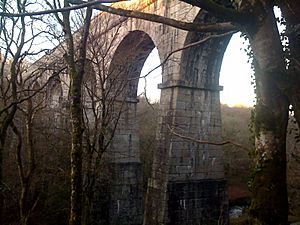Luxulyan Valley facts for kids


The Luxulyan Valley (which means alder tree valley in Cornish) is a beautiful, deep valley in Cornwall, England. It's filled with thick woods and follows the River Par. This valley is special because it has many old industrial buildings and structures from the early 1800s. Because of its history, it was made a World Heritage Site in 2006.
Contents
Exploring the Luxulyan Valley
Where is the Luxulyan Valley?
The Luxulyan Valley stretches for about 5 kilometers (3 miles) from the village of Luxulyan 50°23′24″N 4°44′38″W / 50.390°N 4.744°W down towards the town of St Blazey and the port of Par. It's located in the middle of Cornwall and is part of a larger World Heritage Site called the Cornwall and West Devon Mining Landscape.
Joseph Treffry and the Mining Boom
Most of the old industrial buildings you see in the valley were built by a man named Joseph Treffry (1782–1850). In the early 1800s, copper mining was very popular in Cornwall. Joseph Treffry owned a very important copper mine called Fowey Consols mine. This mine was one of the deepest and richest in Cornwall. At its busiest, it used six steam engines and 17 water wheels to help with the mining work.
Building Connections: Canals and Tramways
To help his mining business, Joseph Treffry built the port of Par Harbour in the late 1820s. He then connected this port to a place called Pontsmill, which is at the southern end of the valley. He did this using the Par Canal.
From the canal, a special mineral tramway was built to carry materials to the mine. In 1835, a second tramway was added. This one used an inclined plane (like a slope for trains) and a flat path along the eastern side of the valley. It also crossed the valley on the huge Treffry Viaduct to reach Luxulyan.
This second tramway was very useful for two main reasons:
- It helped Treffry develop the Carbeans and Colcerrow granite quarries higher up in the valley.
- It also carried water through a leat (a man-made channel) to supply the Fowey Consols mine.
Two other granite quarries, Rock Mill and Orchard, were located lower down in the valley. In 1870, a third tramway was built along the valley floor to connect these quarries to Pontsmill.
The Valley Today: Railways and Quarries
The 1835 tramway eventually became part of the Cornwall Minerals Railway. This railway connected the ports of Par and Fowey on the English Channel with the china clay mines in mid-Cornwall. It also linked to the port of Newquay on the Atlantic Ocean.
To make the railway better for locomotives (train engines), the old tramway route through the valley was changed. A new route was built that climbed more gently. This newer railway line is still used today as part of the Atlantic Coast Line. It actually passes right under the arches of the old Treffry Viaduct!
The older tramway routes continued to be used for the granite quarries until the early 1900s. The last stone was taken from Carbeans quarry in 1933. You can still find a few sections of Treffry's original rails if you look closely.
Ancient History: Tin and Charcoal
The thick woods of the Luxulyan Valley also played a big part in Cornwall's early tin mining. The trees were important for making charcoal. A lot of charcoal was needed to smelt (melt down) tin from the rich alluvial deposits (deposits left by rivers) found on the moors nearby. You can even find old charcoal-burning platforms close to Prideaux Castle.


